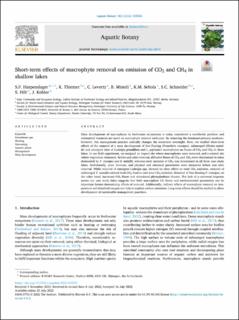| dc.contributor.author | Harpenslager, S.F. | |
| dc.contributor.author | Thiemer, Kirstine | |
| dc.contributor.author | Levertz, C. | |
| dc.contributor.author | Misteli, B. | |
| dc.contributor.author | Sebola, K.M. | |
| dc.contributor.author | Schneider, Susanne Claudia | |
| dc.contributor.author | Hilt, S. | |
| dc.contributor.author | Köhler, J. | |
| dc.date.accessioned | 2022-09-21T11:56:12Z | |
| dc.date.available | 2022-09-21T11:56:12Z | |
| dc.date.created | 2022-08-23T11:51:22Z | |
| dc.date.issued | 2022 | |
| dc.identifier.citation | Aquatic Botany. 2022, 182, 103555. | en_US |
| dc.identifier.issn | 0304-3770 | |
| dc.identifier.uri | https://hdl.handle.net/11250/3020205 | |
| dc.description.abstract | Mass development of macrophytes in freshwater ecosystems is today considered a worldwide problem and substantial resources are spent on macrophyte removal each year. By removing the dominant primary producer, however, this management practice radically changes the ecosystem overnight. Here, we studied short-term effects of the removal of a mass development of free-floating (Pontederia crassipes), submerged (Elodea nuttallii) and emergent (mix of Ludwigia grandiflora and L. peploides) macrophytes on fluxes of CH4 and CO2 in three lakes. In our field experiment, we assigned an impact site where macrophytes were removed, and a control site where vegetation remained. Before and after removal, diffusive fluxes of CO2 and CH4 were determined in lakes dominated by P. crassipes and E. nuttallii, whereas total emission of CH4 was determined in all three case study lakes. Additionally, plant biomass, and physical and chemical parameters were measured before and after removal. While removal of emergent Ludwigia spp. showed no clear effect on total CH4 emission, removal of submerged E. nuttallii reduced both CO2 fixation and total CH4 emission. Removal of free-floating P. crassipes, on the other hand, increased CH4 fluxes and stimulated phytoplankton blooms. The lack of a universal response across our case study lakes suggests that both macrophyte life forms and environmental parameters can be important factors determining effects of removal. Additionally, indirect effects of macrophyte removal on temperature and dissolved oxygen can help to explain carbon emissions. Long-term effects should be studied to allow development of sustainable management practices. | en_US |
| dc.language.iso | eng | en_US |
| dc.publisher | Elsevier | en_US |
| dc.rights | Attribution-NonCommercial-NoDerivatives 4.0 Internasjonal | * |
| dc.rights.uri | http://creativecommons.org/licenses/by-nc-nd/4.0/deed.no | * |
| dc.title | Short-term effects of macrophyte removal on emission of CO2 and CH4 in shallow lakes | en_US |
| dc.type | Peer reviewed | en_US |
| dc.type | Journal article | en_US |
| dc.description.version | publishedVersion | en_US |
| dc.rights.holder | © 2022 The Authors | en_US |
| dc.source.pagenumber | 12 | en_US |
| dc.source.volume | 182 | en_US |
| dc.source.journal | Aquatic Botany | en_US |
| dc.identifier.doi | 10.1016/j.aquabot.2022.103555 | |
| dc.identifier.cristin | 2045273 | |
| dc.relation.project | Norges forskningsråd: 297202 | en_US |
| dc.source.articlenumber | 103555 | en_US |
| cristin.ispublished | true | |
| cristin.fulltext | original | |
| cristin.qualitycode | 1 | |

